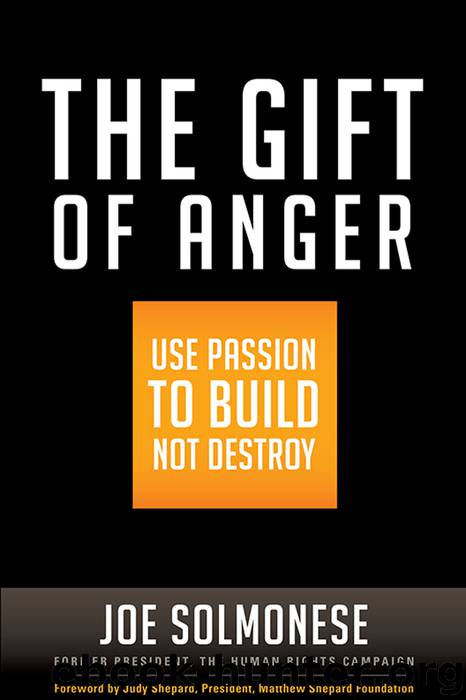The Gift of Anger by Joe Solmonese

Author:Joe Solmonese
Language: eng
Format: epub
Publisher: Berrett-Koehler Publishers, Inc
Published: 2016-06-30T16:00:00+00:00
OVERCOMING DIFFERENCES AT THE INSTITUTIONAL LEVEL
The second type of obstacle to be negotiated is often cultural—that is, the way an organization or institution views the people that comprise it. During my time at the Human Rights Campaign, beginning in 2005, I knew that while it was important to change the makeup of Congress, it would take some time—maybe years. Until both the House and the Senate were occupied by pro-LGBT majorities, we wouldn’t have much success advancing a legislative agenda. However, we still had to figure out a way to get what we wanted. We knew that the ultimate goal was to pass laws in Congress to protect all people from workplace discrimination. In order to do that, we had to create a systematic way for corporate America to change its view about their LGBT employees and to change their willingness to do something for us.
My predecessor at HRC, Elizabeth Birch, began the work of appealing directly to corporations, hospitals, schools, and religious institutions to try to change the experience in these settings for LGBT people. This organizing principle became one of the most significant catalysts for change in the LGBT movement. The goal was to create a more equitable, welcoming, and inclusive experience. For instance, within the American workplace we understood that it would be some time until we could get laws passed that would prohibit workplace discrimination against LGBT people. Instead, we went directly to corporate America and talked with them about implementing policies that would do just that. When we began working with corporations, there were eleven million people in Fortune 500 companies. Even though our long view was that we had to change all of America in terms of the perspective on discrimination in the workplace, we started with these eleven million. We were able to claim significant victories for this segment of America.
We started by finding common ground. The one thing we knew corporate America wanted was a more productive and satisfied workforce. HRC’s argument was that in addition to LGBT people seeking workplace equality, we also wanted the opportunity to bring our whole authentic selves to work every day, and in doing so, to excel and truly contribute as sustained and empowered employees. After establishing that common ground with corporate America, HRC worked on closing the gap between what LGBT people needed for enhanced workplace equality and what each individual institution was prepared to give. Before each meeting, we identified what could be the obstacle that would keep us from getting what we wanted. Then, each ask—from inclusive nondiscrimination policies to domestic partner benefits—was justified in a way that benefitted not only LGBT people but all of the stakeholders. We made the case again and again that anything the companies or institutions did to foster a more welcoming and inclusive environment was simply good for the bottom line. With each “yes” we received, the differences grew smaller as we worked together to create a more vibrant workforce and to tap into a powerful consumer base.
Download
This site does not store any files on its server. We only index and link to content provided by other sites. Please contact the content providers to delete copyright contents if any and email us, we'll remove relevant links or contents immediately.
| African-American Studies | Asian American Studies |
| Disabled | Ethnic Studies |
| Hispanic American Studies | LGBT |
| Minority Studies | Native American Studies |
Cecilia; Or, Memoirs of an Heiress — Volume 1 by Fanny Burney(32495)
Cecilia; Or, Memoirs of an Heiress — Volume 2 by Fanny Burney(31909)
Cecilia; Or, Memoirs of an Heiress — Volume 3 by Fanny Burney(31893)
The Great Music City by Andrea Baker(31758)
We're Going to Need More Wine by Gabrielle Union(19003)
All the Missing Girls by Megan Miranda(15779)
Pimp by Iceberg Slim(14434)
Bombshells: Glamour Girls of a Lifetime by Sullivan Steve(14022)
For the Love of Europe by Rick Steves(13587)
Talking to Strangers by Malcolm Gladwell(13290)
Norse Mythology by Gaiman Neil(13279)
Fifty Shades Freed by E L James(13187)
Mindhunter: Inside the FBI's Elite Serial Crime Unit by John E. Douglas & Mark Olshaker(9263)
Crazy Rich Asians by Kevin Kwan(9223)
The Lost Art of Listening by Michael P. Nichols(7453)
Enlightenment Now: The Case for Reason, Science, Humanism, and Progress by Steven Pinker(7273)
The Four Agreements by Don Miguel Ruiz(6701)
Bad Blood by John Carreyrou(6583)
Weapons of Math Destruction by Cathy O'Neil(6215)
